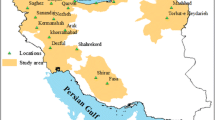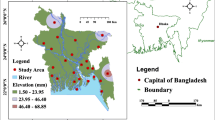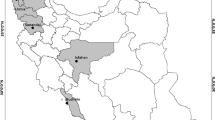Abstract
ET0 is an important hydro-meteorological phenomenon, which is influenced by changing climate like other climatic parameters. This study investigates the present and future trends of ET0 in Bangladesh using 39 years’ historical and downscaled CMIP5 daily climatic data for the twenty-first century. Statistical Downscaling Model (SDSM) was used to downscale the climate data required to calculate ET0. Penman–Monteith formula was applied in ET0 calculation for both the historical and modelled data. To analyse ET0 trends and trend changing patterns, modified Mann–Kendall and Sequential Mann–Kendall tests were, respectively, done. Spatial variations of ET0 trends are presented by inverse distance weighting interpolation using ArcGIS 10.2.2. Results show that RCP8.5 (2061–2099) will experience the highest amount of ET0 totals in comparison to the historical and all other scenarios in the same time span of 39 years. Though significant positive trends were observed in the mid and last months of year from month-wise trend analysis of representative concentration pathways, significant negative trends were also found for some months using historical data in similar analysis. From long-term annual trend analysis, it was found that major part of the country represents decreasing trends using historical data, but increasing trends were observed for modelled data. Theil–Sen estimations of ET0 trends in the study depict a good consistency with the Mann–Kendall test results. The findings of the study would contribute in irrigation water management and planning of the country and also in furthering the climate change study using modelled data in the context of Bangladesh.









Similar content being viewed by others
References
Ahmed R, Karmakar S (1993) Arrival and withdrawal dates of the summer monsoon in Bangladesh. Int J Climatol 137:727–740. https://doi.org/10.1002/joc.3370130703
Ahmed R, Kim I (2003) Patterns of daily rainfall in Bangladesh during the summer monsoon season: case studies at three stations. Phys Geogr 24:295–318
Ahmad I, Tang D, Wang T, Wang M, Wagan B (2015) Precipitation trends over time using Mann-Kendall and Spearman’s rho tests in swat river basin, Pakistan. Adv Meteorol. https://doi.org/10.1155/2015/431860
Alexandersson H (1986) A homogeneity test applied to precipitation data. Int J Climatol 6:661–675
Ali A (1996) Vulnerability of Bangladesh to climate change and sea level rise through tropical cyclones and storm surges. Water Air Soil Pollut 92:171–179
Allen RG, Pereira LS, Raes D, Smith M (1998) Crop evapotranspiration-Guidelines for computing crop water requirements-FAO Irrigation and drainage paper 56. FAO, Rome 300(9):D05109
Amarasinghe UA, Sharma BR, Muthuwatta L, Khan ZH (2014) Water for food in Bangladesh: outlook to 2030. Colombo, Sri Lanka: International Water Management Institute (IWMI). 32p. IWMI Research Report 158. http://doi.org/10.5337/2014.213
Attarod P, Kheirkhah F, Sigaroodi SK, Sadeghi SMM (2015) Sensitivity of Reference Evapotranspiration to Global Warming in the Caspian Region, North of Iran. J Agr Sci Tech 17:869–883
Ayub R, Miah MM (2011) Effects of change in temperature on reference crop evapotranspiration (ETo) in the northwest region of Bangladesh. In: The fourth annual paper meet and 1st civil engineering congress, December, 2011, Dhaka, pp 978–984
Bayazit M, Önöz B (2008) To prewhiten or not to prewhiten in trend analysis? Hydrol Sci J 52:611–624. https://doi.org/10.1623/hysj.52.4.611
Blain GC (2013) The Mann–Kendall test: the need to consider the interaction between serial correlation and trend. Agric Eng. https://doi.org/10.4025/actasciagron.v35i4.16006
Buishand TA (1982) Some methods for testing the homogeneity of rainfall records. J Hydrol 58:11–27
Bultot F, Dupriez GL, Gellens D (1988) Estimated annual regime of energy balance components, evapotranspiration and soil moisture for a drainage basin in case of a CO2 doubling. Clim Chang 12:39–56. https://doi.org/10.1007/BF00140263
Climate Change Cell (2008) Economic modeling of climate change adaptation needs for physical infrastructures in Bangladesh Department of Environment, Ministry of Environment and Forests, Component 4b. Comprehensive Disaster Management Programme, Ministry of Food and Disaster Management, Bangladesh
Das GA, Singh BM, Albert X, Mark O (2005) Water sector of Bangladesh in the context of integrated water resources management: a review. Int J Water Resour D 21:385–398. https://doi.org/10.1080/07900620500037818
Ericksen NJ, Ahmad QK, Chowdhury AR (1996) Socio-economic implications of climate change for Bangladesh. The implications of climate and sea-level change for Bangladesh. Springer, Netherlands, pp 205–287
Gleick PH (1986) Methods for evaluating the regional hydrologic impacts of global climatic changes. J Hydrol 88:97–116. https://doi.org/10.1016/0022-1694(86)90199-X
Goyal RK (2004) Sensitivity of evapotranspiration to global warming: a case study of arid zone of Rajasthan (India). Agric Water Manag 69:1–11. https://doi.org/10.1016/j.agwat.2004.03.014
Hamed KH, Rao AR (1998) A modified Mann–Kendall trend test for autocorrelated data. J Hydrol 204:182–196. https://doi.org/10.1016/S0022-1694(97)00125-X
Haylock MR, Cawley GC, Harpham C, Wilby RL, Goodess CM (2006) Downscaling heavy precipitation over the UK: a comparison of dynamical and statistical methods and their future scenarios. Int J Climatol 26:1397–1415. https://doi.org/10.1002/joc.1318
Hirsch RM, Slack JR (1984) A nonparametric trend test for seasonal data with serial dependence. Water Resour Res 20:727–732. https://doi.org/10.1029/WR020i006p00727
Immerzeel W (2008) Historical trends and future predictions of climate variability in the Brahmaputra basin. Int J Climatol 28:243–254. https://doi.org/10.1002/joc.1528
IPCC (2007) Climate change 2007: impacts, adaptation and vulnerability. In: Parry ML, Canziani OF, Palutikof JP, van der Linden PJ, Hanson CE (eds) Contribution of Working Group II to the Fourth Assessment Report of the Intergovernmental Panel on Climate Change. Cambridge University Press, Cambridge, p 976
IPCC (2013) Climate change 2013: the physical science basis. In: Stocker TF, Qin D, Plattner G-K, Tignor M, Allen SK, Boschung J, Nauels A, Xia Y, Bex V, Midgley PM (eds) Contribution of Working Group I to the Fifth Assessment Report of the Intergovernmental Panel on Climate Change. Cambridge University Press, Cambridge. http://doi.org/10.1017/CBO9781107415324
Ji F, Wu Z, Huang J, Chassignet EP (2014) Evolution of land surface air temperature trend. Nat Clim Chang 4:462–466. https://doi.org/10.1038/nclimate2223
Jones P (1999) The Instrumental Data Record: Its accuracy and use in attempts to identify the “CO2 Signal”. Analysis of climate variability. Springer, Berlin, pp 53–76
Karim MF, Mimura N (2008) Impacts of climate change and sea-level rise on cyclonic storm surge floods in Bangladesh. Glob Environ Chang 18:490–500. https://doi.org/10.1016/j.gloenvcha.2008.05.002
Karim NN, Talukder MSU, Hassan AA, Khair MA (2008) Temporal trend of reference crop evapotranspiration due to changes of climate in North Central hydrological region of Bangladesh. J Agric Eng 34/AE:91–100
Karl R, Williams CN Jr (1987) An approach to adjusting climatological time series for discontinuous inhomogeneities. J Climatol Appl Meteorol 26:1744–1763
Kendall MG (1975) Rank correlation methods. Griffin and Co, London
Khalil AA (2013) Effect of climate change on evapotranspiration in Egypt. Researcher 55:7–12. https://doi.org/10.9780/22307850
Kumar S, Merwade V, Kam J, Thurner K (2009) Stream flow trends in Indiana: effects of long term persistence, precipitation and subsurface drains. J Hydrol 374:171–183. https://doi.org/10.1016/j.jhydrol.2009.06.012
Kundu S, Khare D, Mondal A (2017) Future changes in rainfall, temperature and reference evapotranspiration in the central India by least square support vector machine. Geosci Front 8:583–596. https://doi.org/10.1016/j.gsf.2016.06.002
Lorentzen T (2014) Statistical analysis of temperature data sampled at Station-M in the Norwegian Sea. J Mar Syst 130:31–45. https://doi.org/10.1016/j.jmarsys.2013.09.009
Mann HB (1945) Nonparametric tests against trend. Econometrica 13:245–259. http://doi.org/0012-9682(194507)13:3<245:NTAT>2.0.CO;2-U
Martin P, Rosenberg NJ, Kenney MMS (1989) Sensitivity of evapotranspiration in wheat field, afforest and a grassland to change in climate and direct effect of carbon dioxide. Clim Chang 14:117–151
Mirza MMQ (2002) Global warming and changes in the probability of occurrence of floods in Bangladesh and implications. Glob Environ Chang 12:127–138. https://doi.org/10.1016/S0959-3780(02)00002-X
Mojid MA, Rannu RP, Karim NN (2015) Climate change impacts on reference crop evapotranspiration in northwest hydrological region of Bangladesh. Int J Climatol 35:4041–4046. https://doi.org/10.1002/joc.4260
Moratiel R, Durán JM, Snyder RL (2010) Responses of reference evapotranspiration to changes in atmospheric humidity and air temperature in Spain. Clim Res 44:27–40. https://doi.org/10.3354/cr00919
Nalley D, Adamowski J, Khalil B, Ozga-Zielinski B (2013) Trend detection in surface air temperature in Ontario and Quebec, Canada during 1967–2006 using the discrete wavelet transforms. Atmos Res 132:375–398. https://doi.org/10.1016/j.atmosres.2013.06.011
Nemec J, Schaake J (1982) Sensitivity of water resources system to climate variation. Hydrol Sci J 27:327–343. https://doi.org/10.1080/02626668209491113
Nick FM, Vieli A, Howat IM, Joughin I (2009) Large scale changes in Greenland outlet glacier dynamics triggered at the terminus. Nat Geosci 2:110–114. https://doi.org/10.1038/ngeo394
Önöz B, Bayazit M (2012) Block bootstrap for Mann–Kendall trend test of serially dependent data. Hydrol Process 26:3552–3560. https://doi.org/10.1002/hyp.8438
Peterson TC, Easterling DR, Karl TR, Groisman P, Nicholls N, Plummer N, Torok S, Auer I, Boehm R, Gullett D, Vincent L, Heino R, Tuomenvirta H, Mestre O, Szentimrey T, Salinger J, Førland EJ, Hanssen-Bauer I, Alexandersson H, Jones P, Parker D (1998) Homogeneity adjustments of in situ atmospheric climate data: a review. Int J Climatol 18:1493–1517. https://doi.org/10.1002/(SICI)1097-0088(19981115)18:13<1493:AID-JOC329>3.0.CO;2-T
Rabby YW, Shogib RI, Hossain L (2015) Analysis of temperature change in capital city of Bangladesh. J Environ Treat Tech 3:55–59
Radziejewski M, Zbigniew WK (2004) Detectability of changes in hydrological records/Possibilité de détecter les changements dans les chroniques hydrologiques. Hydrol Sci J 49:39–51
Rahman MR, Lateh H (2015) Climate change in Bangladesh: a spatio-temporal analysis and simulation of recent temperature and rainfall data using GIS and time series analysis model. Theor Appl Climatol. https://doi.org/10.1007/s00704-015-1688-3
Rahman MA, Yunsheng L, Sultana N (2017) Analysis and prediction of rainfall trends over Bangladesh using Mann-Kendall, Spearman’s rho tests and ARIMA model. Meteorol Atmos Phys 129:409–424. https://doi.org/10.1007/s00703-016-0479-4
Rashid HE (1991) Geography of Bangladesh. University Press Ltd, Dhaka
Rosenberg NJ, Kenney MMS, Martin P (1989) Evapotranspiration in greenhouse warmed world: a review and a simulation. Agric For Meteorol 47:303–320. https://doi.org/10.1016/0168-1923(89)90102-0
Sen PK (1968) Estimates of the regression coefficient based on Kendall’s tau. J Am Stat Assoc 63:1379–1389
Shahid S (2010) Rainfall variability and the trends of wet and dry periods in Bangladesh. Int J Climatol 30:2299–2313. https://doi.org/10.1002/joc.2053
Shahid S (2011) Impact of climate change on irrigation water demand of dry season Boro rice in northwest Bangladesh. Clim Chang 105:433–453. https://doi.org/10.1007/s10584-010-9895-5
Solomon S, Qin D, Manning M, Alley RB, Berntsen T, Bindoff NL, Chen Z, Chidthaisong A, Gregory JM, Hegerl GC, Heimann M, Hewitson B, Hoskins BJ, Joos F, Jouzel J, Kattsov V, Lohmann U, Matsuno T, Molina M, Nicholls N, Overpeck J, Raga G, Ramaswamy V, Ren J, Rusticucci M, Somerville R, Stocker TF, Whetton P, Wood RA, Wratt D (2007) Technical summary. In: Solomon S, Qin D, Manning M, Chen Z, Marquis M, Averyt KB, Tignor M, Miller HL (eds) Climate CHANGE 2007: THE PHYSICAL SCIENCE BASIS. Contribution of Working Group I to the fourth assessment report of the Intergovernmental Panel on Climate Change. Cambridge University Press, Cambridge
Sun S, Chen H, Wang G, Li J, Mu M, Yan G, Xu B, Huang J, Wang J, Zhang F, Zhu S (2016) Shift in potential evapotranspiration and its implications for dryness/wetness over Southwest China. J Geophys Res Atmos 121:9342–9355. https://doi.org/10.1002/2016JD025276
Sun S, Chen H, Ju W, Wang G, Sun G, Huang J, Ma H, Gao C, Hua W, Yan G (2017a) On the coupling between precipitation and potential evapotranspiration: contributions to decadal drought anomalies in the Southwest China. Clim Dyn 48:3779–3797. https://doi.org/10.1007/s00382-016-3302-5
Sun S, Wang G, Huang J, Mu M, Yan G, Liu C, Gao C, Li X, Yin Y, Zhang F, Zhu S, Hua W (2017b) Spatial pattern of reference evapotranspiration change and its temporal evolution over Southwest China. Theor Appl Climatol 130:979–992. https://doi.org/10.1007/s00704-016-1930-7
Theil H (1950) A rank-invariant method of linear and polynomial regression analysis. I, II, III. Nederl Akad Wetensch Proc 53:386–392, 521–525, 1397–1412
van Vuuren DP, Edmonds J, Kainuma M, Riahi K, Thomson A, Hibbard K, Hurtt GC, Kram T, Krey V, Lamarque J-F, Masui T, Meinshausen M, Nakicenovic N, Smith SJ, Rose SK (2011) The representative concentration pathways: an overview. Clim Chang 109:5–31. https://doi.org/10.1007/s10584-011-0148-z
Wetterhall F, Halldin S, Xu CY (2007) Seasonality properties of four statistical-downscaling methods in central Sweden. Theor Appl Climatol 87:123–137. https://doi.org/10.1007/s00704-005-0223-3
Wilby RL, Dawson CW (2007) User’s Manual for SDSM 4.2—a decision support tool for the assessment of regional climate change impacts. Loughborough University, UK. http://co-public.lboro.ac.uk/cocwd/SDSM/SDSMManual.pdf. Accessed 20 Oct 2016
Wilby RL, Harris I (2006) A framework for assessing uncertainties in climate change impacts: low flow scenarios for the River Thames, UK. Water Resour Res 42:W02419. http://doi.org/10.1029/2005WR004065
Wilby RL, Wigley TML, Conway D, Jones PD, Hewitson BC, Main J, Wilks DS (1998) Statistical downscaling of general circulation model output: a comparison of methods. Water Resour Res 34:2995–3008. https://doi.org/10.1029/98WR02577
Yaseen M, Bhatti HA, Rientjes T, Nabi G, Latif M (2013) Temporal and spatial variations in summer flows of upper Indus Basin, Pakistan. In: Proceedings of the 72nd annual session of Pakistan engineering congress, December, 2013, pp 315–334
Yaseen M, Bhatti HA, Rientjes T, Nabi G, Latif M (2014) Assessment of recent temperature trends in Mangla watershed. J Himalayan Earth Sci 47:107–121
Zhao J, Xu Z, Zuo D, Wang X (2015) Temporal variations of reference evapotranspiration and its sensitivity to meteorological factors in Heihe River Basin, China. Water Sci Eng 8:1–8. https://doi.org/10.1016/j.wse.2015.01.004
Acknowledgements
The authors would like to express their gratitude to Chinese Government Scholarship Council (CSC) and to Nanjing University of Information Science and Technology (NUIST) for different forms of supports. The authors are also thankful to Bangladesh Meteorological Department (BMD) for providing climate data used in this study. Special thanks go to the anonymous reviewers who contributed much in improving the quality of this paper.
Author information
Authors and Affiliations
Corresponding author
Additional information
Responsible Editor: J.-T. Fasullo.
Rights and permissions
About this article
Cite this article
Rahman, M.A., Yunsheng, L., Sultana, N. et al. Analysis of reference evapotranspiration (ET0) trends under climate change in Bangladesh using observed and CMIP5 data sets. Meteorol Atmos Phys 131, 639–655 (2019). https://doi.org/10.1007/s00703-018-0596-3
Received:
Accepted:
Published:
Issue Date:
DOI: https://doi.org/10.1007/s00703-018-0596-3




